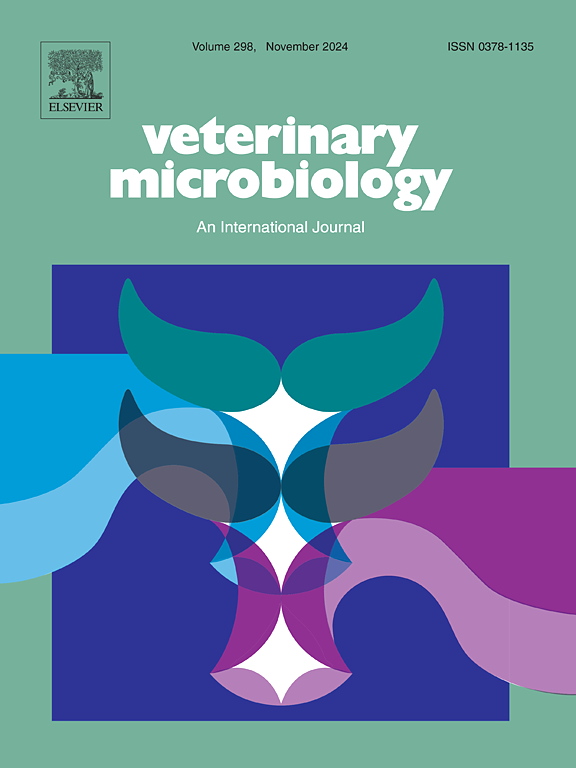A matched case-control study of porcine group A and C rotaviruses in a swine farrowing production system
IF 2.4
2区 农林科学
Q3 MICROBIOLOGY
引用次数: 0
Abstract
Group A rotaviruses (RVA) and group C rotaviruses (RVC) are important enteric pathogens in swine. Comprehensive studies investigating porcine rotaviruses in Canada are necessary to enhance understanding of the frequency, impacts, and dynamics of these infections in swine herds. This study aims to estimate the prevalence of RVA and RVC, describe circulating strains, and assess the association of rotaviruses with diarrhea at the piglet, litter, and batch levels in Canadian farrowing swine productions. A matched case-control study was conducted on farrowing farms within an integrated production system experiencing a diarrheic episode. Rectal swabs from 94 diarrheic piglets and 127 healthy piglets were collected and subjected to VP7 and VP4 gene amplification of RVA and RVC using RT-PCR. Results indicated a 45.4 % and 27.4 % prevalence for RVA and RVC in piglets, respectively. A significant association between RVC and diarrhea (odds ratio = 7.1; p = 0.02) was identified at the batch level, while RVA detection did not show a significant relationship with diarrhea. Molecular characterization of various RVA and RVC strains detected in this study described at least four different RVA strains and three different RVC strains circulating on farms within the integrated production system. This study estimates the prevalence of RVA and RVC and describes the main viral strains in swine herds experiencing an episode of neonatal diarrhea. While it also highlights the importance of RVC in piglet diarrhea when detected in a batch, results from his study warrant the implementation of additional prevention measures and regular surveillance for the control of both RVA and RVC in swine herds.
猪A组和C组轮状病毒在猪生产系统中的匹配病例对照研究。
A组轮状病毒(RVA)和C组轮状病毒(RVC)是猪重要的肠道病原体。在加拿大对猪轮状病毒进行全面的研究是必要的,以加强对猪群中这些感染的频率、影响和动态的了解。本研究旨在估计RVA和RVC的流行程度,描述循环毒株,并评估轮状病毒与加拿大产猪生产中仔猪、产仔和批次水平腹泻的关系。一项匹配的病例对照研究是在一个综合生产系统内发生腹泻的产猪场进行的。收集94头腹泻仔猪和127头健康仔猪直肠拭子,采用RT-PCR技术扩增RVA和RVC的VP7和VP4基因。结果表明,仔猪RVA和RVC的患病率分别为45.4% %和27.4% %。RVC与腹泻之间存在显著关联(优势比= 7.1;p = 0.02),而RVA检测未显示与腹泻有显著关系。本研究中检测到的各种RVA和RVC菌株的分子特征描述了在综合生产系统内的农场中传播的至少四种不同的RVA菌株和三种不同的RVC菌株。本研究估计了RVA和RVC的流行率,并描述了经历新生儿腹泻发作的猪群中的主要病毒株。虽然它也强调了在一批仔猪腹泻中检测到RVC的重要性,但他的研究结果证明了在猪群中实施额外的预防措施和定期监测RVA和RVC的控制。
本文章由计算机程序翻译,如有差异,请以英文原文为准。
求助全文
约1分钟内获得全文
求助全文
来源期刊

Veterinary microbiology
农林科学-兽医学
CiteScore
5.90
自引率
6.10%
发文量
221
审稿时长
52 days
期刊介绍:
Veterinary Microbiology is concerned with microbial (bacterial, fungal, viral) diseases of domesticated vertebrate animals (livestock, companion animals, fur-bearing animals, game, poultry, fish) that supply food, other useful products or companionship. In addition, Microbial diseases of wild animals living in captivity, or as members of the feral fauna will also be considered if the infections are of interest because of their interrelation with humans (zoonoses) and/or domestic animals. Studies of antimicrobial resistance are also included, provided that the results represent a substantial advance in knowledge. Authors are strongly encouraged to read - prior to submission - the Editorials (''Scope or cope'' and ''Scope or cope II'') published previously in the journal. The Editors reserve the right to suggest submission to another journal for those papers which they feel would be more appropriate for consideration by that journal.
Original research papers of high quality and novelty on aspects of control, host response, molecular biology, pathogenesis, prevention, and treatment of microbial diseases of animals are published. Papers dealing primarily with immunology, epidemiology, molecular biology and antiviral or microbial agents will only be considered if they demonstrate a clear impact on a disease. Papers focusing solely on diagnostic techniques (such as another PCR protocol or ELISA) will not be published - focus should be on a microorganism and not on a particular technique. Papers only reporting microbial sequences, transcriptomics data, or proteomics data will not be considered unless the results represent a substantial advance in knowledge.
Drug trial papers will be considered if they have general application or significance. Papers on the identification of microorganisms will also be considered, but detailed taxonomic studies do not fall within the scope of the journal. Case reports will not be published, unless they have general application or contain novel aspects. Papers of geographically limited interest, which repeat what had been established elsewhere will not be considered. The readership of the journal is global.
 求助内容:
求助内容: 应助结果提醒方式:
应助结果提醒方式:


